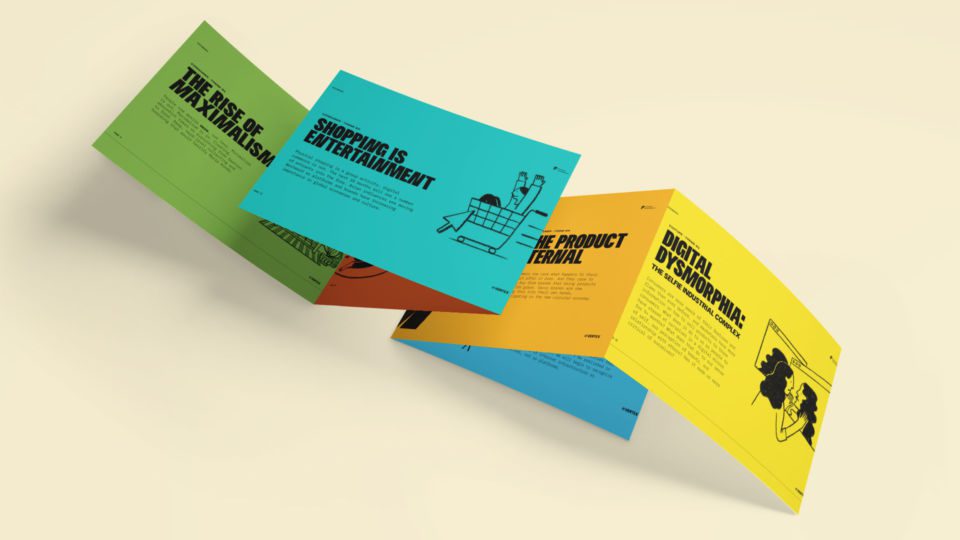Seismic shifts in consumer trends accelerated by the pandemic will have long-lasting implications for the retail industry at large. A new report, Vision 2021, from research and media company Future Commerce, highlights 10 emergent trends related to retail, cultural shifts and technological modernity that are shaping how consumers interact with the world. The trends include:
- Shopping as entertainment: A strengthening of the long-term trend toward experiential retail;
- Digital dysmorphia: So much time spent on Zoom has made people more conscious of physical flaws in themselves and others;
- The product eternal: More consumers are expressing concerns about the fate of products after they are done with them; and
- The age of fractional ownership: More people investing in non-traditional securities such as wines, jewelry and luxury/designer goods.
Future Commerce partnered with Method + Mode to conduct broad consumer research over a period of three months ending in January 2021. The study used a nationally representative sample of more than 1,000 consumers and feedback from the Future Commerce Expert Network, a group of knowledgeable retail and brand operators.
The report includes a look back at 2020 and what drove these shifts in behavior during a year when consumers spent more time online than ever before, as well as forward-looking projected areas of consumer engagement in 2021 and beyond.
“The widening class schism, the political and racial tensions, environmental difference, and the isolation and death due to COVID-19 we’ve experienced over the past year have deepened our already-dominant American cynicism,” said Brian Lange, Co-Founder of Future Commercein an interview with Retail TouchPoints. “This cynicism is manifesting itself in more extreme and ironic appetites. Boring won’t cut it. The attention economy will demand that brands bring their best creative selves to the table and traditional methods of marketing and selling will see a rapid decline in effectiveness.”
The report divided the trends into three main categories: Consumer, Culture and Modernity:
Consumer Trends
The Rise of Maximalism – Consumers are taking things to extremes and the absurd. The desire for more, not less, is winning the battle for our psyches.
- 52% feel that being with their “stuff” makes them happy;
- 60% say surrounding themselves with things they love makes them feel safe/in control; and
- 22% say they’re “collectors.”
Shopping as Entertainment – Physical shopping is a group activity, but digital commerce is not. Shopping will have to be relational, fun, engaging, relaxing and keep our attention.
- 51% miss “going shopping” as a way to socialize; and
- 25% regularly tune into video shopping channels like QVC or HSN.
Brands as Performance Art –The intersectionality of meme culture, hype culture and get-rich-quick schemes are manifesting in brand performance art.
- 40% say they’ve purchased something promoted by someone they follow on social but don’t know personally; and
- More than one in three (37%) are following top-ranking influencers.
The Product Eternal – Consumers now care what happens to their product after it dies, so the new circular economy is dictating who they now choose to buy from.
- 81% of people have actively secured a second life for their items.
Of all these shifting consumer trends, shopping as entertainment will have a pronounced impact on retail’s future. “Shopping as entertainment is nothing new, but this next iteration is both essential and necessary,” said Lange.“The attention switch from traditional entertainment providers toward independent creators on platforms like YouTube and TikTok, along with a massive channel shift from more conventional fare to media brands like Netflix and Amazon, is providing opportunities for brands to focus their energy on more niche and relevant audiences. This means better content and better conversion.”
Culture Trends
Digital Dysmorphia: The Selfie Industrial Complex – Consumers are more aware of their features and flaws than ever, and marketers have new insights into how to sell to them.
- 50% say they’re more aware of their appearance as a result of increased FaceTime/Zoom;
- 38% agree they’re more critical of their appearance and of others; and
- 26% have upgraded their tech for increased on-screen time.
Brands and the Widening Class Schism – The “K-shape recovery” will spur further disparity between luxury and mass-market experiences.
- A “trusted brand” is 2X more important than a luxury pedigree.
The Death and Rebirth of Neutrality – It’s virtually impossible to be impartial now. Lines have been drawn, and consumers are demanding that corporations take political sides.
- 57% consider Facebook, Amazon and Google essential services at this point; and
- Millennials have the highest expectations for corporations to step in where government fails.
Modernity Trends
The Age of Fractional Ownership – What started with high-value tangible assets now has mass accessibility. Consumers can own infinitesimally small pieces of, well, anything.
- 53% of consumers report investing in non-traditional securities this year; wine, luxury/designer goods and fine jewelry were top of the list.
Capitalism and the Digital Commons – The lack of common spaces and increasing physical isolation is leading to the growth of one-on-one interactions via digital channels.
- 89% have spent time with friends and family in person this year – primarily at their homes, or the homes of loved ones – despite COVID-related challenges.
Convergence of the Meta and the Physical – Traditional spaces are diminishing, and those that remain are changing. Place is no longer just physical. Digital “neighborhoods” that spark purchase intent are the future: YouTube, Instagram and Pinterest are cities unto themselves that contain neighborhoods of like-minded and interdependent brands.
- 1 in 3 consumers consider themselves “gamers”; and
- 62% feel online and offline have converged – that they project their whole/authentic selves at all times.
This last trend — the convergence of meta and physical — will affect the role of both the physical store and its design. “The convergence of the meta and the physical is happening online, but the reverse is also true,” Lange said. “This year we’ll see rising engagement with digital in-store — with the potential for a majority of physical transactions being digitally influenced in the moment. Reviews, coupons, discounts, pricing, product info and more will be accessed by shoppers via their own devices before making their in-store purchase. Retailers who tune their brick-and-mortar experiences to reduce friction by fusing their online and offline systems will reap the benefits.”
To view the full report, visit https://futurecommerce.fm/vision.













